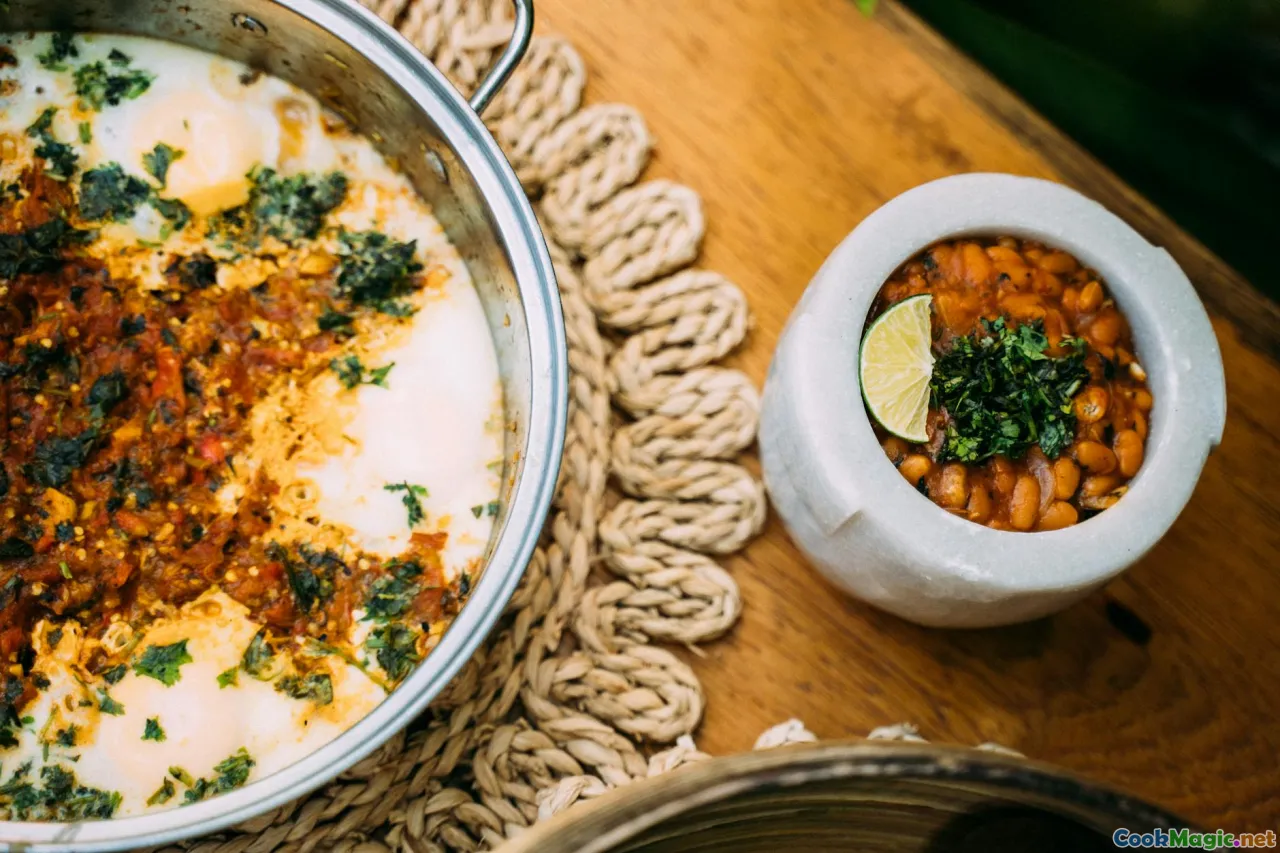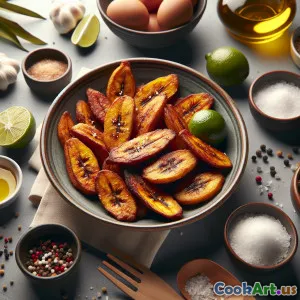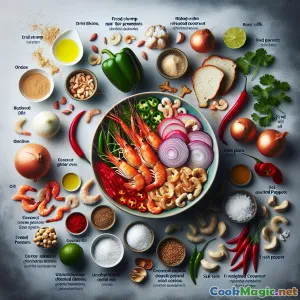
Rustic Antioquian Frijolada with Arepas & Plantain
(0 Reviews)Ingredients
-
400 grams Cranberry beans (fríjol cargamanto)
(Or substitute with pinto or red kidney beans if unavailable)
-
200 grams Smoked chorizo sausage
(Cut into slices; Spanish-style ideally)
-
250 grams Pork belly
(Trimmed and cubed)
-
150 grams Cassava (Yuca)
(Peeled and cubed)
-
2 medium, peeled Potato
(Diced)
-
2 medium Carrot
(Diced)
-
100 grams White hominy corn (mote)
(Precooked hominy, rinsed; can omit for gluten-free)
-
1 large Ripe plantain
(Cut into half-moons)
-
2 large Tomato
(Finely chopped)
-
1 large Onion
(Finely chopped)
-
3 stalks Scallion (green onion)
(Sliced)
-
4 cloves Garlic
(Minced)
-
20 grams Fresh cilantro
(Chopped, plus extra for garnishing)
-
1.5 teaspoons Cumin powder
-
1 teaspoon Achiote (annatto) powder
(Optional, for color)
-
2 whole Bay leaves
Salt, to taste
Freshly ground black pepper, to taste
-
2 tablespoons Vegetable oil
-
2 liters Water
(Reserve more as necessary)
-
6 small Arepas
(For serving)
-
1 large Avocado
(Sliced for garnish)
(Or substitute with pinto or red kidney beans if unavailable)
(Cut into slices; Spanish-style ideally)
(Trimmed and cubed)
(Peeled and cubed)
(Diced)
(Diced)
(Precooked hominy, rinsed; can omit for gluten-free)
(Cut into half-moons)
(Finely chopped)
(Finely chopped)
(Sliced)
(Minced)
(Chopped, plus extra for garnishing)
(Optional, for color)
(Reserve more as necessary)
(For serving)
(Sliced for garnish)
Nutrition
- Servings: 6
- Serving Size: 1 hearty bowl (~350g)
- Calories: 550 kcal
- Carbohydrates: 65 g
- Protein: 23 g
- Fat: 18 g
- Fiber: 13 g
- Sugar: 7 g
- Sodium: 950 mg
- Cholesterol: 34 mg
- Calcium: 120 mg
- Iron: 3.2 mg
Instructions
-
1 - Soak the Beans:
Rinse cranberry beans thoroughly. Place in a large bowl, cover with water, and soak overnight (8 hours). Drain and set aside.
-
2 - Prepare and Sauté Base:
In a large heavy pot, heat the vegetable oil over medium heat. Add onion, scallion, garlic, carrot, and tomato; sauté until soft and aromatic (about 7 minutes). Stir in cumin and optional achiote.
-
3 - Brown the Chorizo & Pork:
Add chorizo and pork belly pieces. Cook until browned and some fat is rendered, about 10 minutes.
-
4 - Simmer the Stew:
Add beans, hominy, bay leaves, and water. Bring to a boil, reduce to low, cover, and simmer for 60–75 minutes, stirring occasionally.
-
5 - Add Vegetables & Plantain:
Add cubed potatoes, yuca, and plantain. Continue to simmer uncovered for 30–40 minutes until all is tender and stew is thickened.
-
6 - Season and finish:
Check for seasoning; add salt and pepper as needed. Stir in fresh cilantro. Remove bay leaves.
-
7 - Serve:
Ladle hot frijolada into bowls. Garnish with more cilantro and serve with arepas and sliced avocado on the side. Enjoy!
Rinse cranberry beans thoroughly. Place in a large bowl, cover with water, and soak overnight (8 hours). Drain and set aside.
In a large heavy pot, heat the vegetable oil over medium heat. Add onion, scallion, garlic, carrot, and tomato; sauté until soft and aromatic (about 7 minutes). Stir in cumin and optional achiote.
Add chorizo and pork belly pieces. Cook until browned and some fat is rendered, about 10 minutes.
Add beans, hominy, bay leaves, and water. Bring to a boil, reduce to low, cover, and simmer for 60–75 minutes, stirring occasionally.
Add cubed potatoes, yuca, and plantain. Continue to simmer uncovered for 30–40 minutes until all is tender and stew is thickened.
Check for seasoning; add salt and pepper as needed. Stir in fresh cilantro. Remove bay leaves.
Ladle hot frijolada into bowls. Garnish with more cilantro and serve with arepas and sliced avocado on the side. Enjoy!
More About: Rustic Antioquian Frijolada with Arepas & Plantain
Antioquian Heritage Frijolada: Colombia’s Celebration in a Bowl
Introduction
Frijolada is more than a dish in Antioquia—it is a living echo of Colombia’s Andean soul. Steaming bowls laden with plump beans, chorizo, and root vegetables exist at the crossroads of the rural dinner table, the family reunion, and the region’s agricultural bounty. 'Antioquian Heritage Frijolada' is my creative ode to that time-tested mingling of earth, kitchen, and culture.
History & Cultural Significance
At its roots, Frijolada is descended from traditional Spanish and indigenous stews, carried into Colombian homes on the backs of economic migration, trade, and resourcefulness. Antioquia’s famous 'fríjol cargamanto' (buttery cranberry beans) are unique to the mountain farms surrounding Medellín and are a pillar of identity for the region, often making appearances at every major celebration or gathering. Meat—smoked chorizo, slabs of pork—and an array of tubers (cassava, potato) underpin the stew with substance and flavor. Plantains, cilantro, and hominy evoke the tropical facets of the Colombian landscape.
On Sundays or festive family occasions, Frijolada shares table space with arepas, rice, fried plantain, and slices of fresh avocado. Its communal pot radiates hospitality, thrift, and the pleasure of slow meals—a reminder that togetherness always starts in the kitchen.
Unique Aspects & Chef’s Notes
This recipe offers a contemporary tribute to a timeworn favorite, inclusion sectional ingredients (like yuca and hominy) that may not always appear together, but each embodies a part of Colombia’s layered ancestry: indigenous (corn, beans), European (chorizo), and African (root vegetables).
Key features that make this Frijolada special:
- Double starch: Potatoes and yuca provide contrasting textures, earthy flavors, and thicken the broth.
- Color & aromatics: Annatto (achiote) not only enriches color but releases gentle notes reminiscent of Colombian kitchens.
- Layered proteins: Chorizo and pork belly cook slowly, releasing flavors that bind the stew—fat adds essential mouthfeel.
- Plantain’s sweetness: Ripe plantain, sliced in at the end, imparts balancing sweetness.
- Fresh garnishes: Cilantro and avocado bring green notes that cut through the stew’s richness, while rustic arepas offer a soft base for its juices.
Feel free to swap in other legumes or tubers, or highlight your favorite Colombian sausage. If you favor a vegetarian take, omit meats and double up the beans, flavoring richly with smoked paprika and extra cumin.
Preparation Tips
- Soaking beans overnight reduces cooking time and improves digestibility.
- Cutting all vegetables before starting makes the cooking flow smoothly.
- Taste and adjust: Colombian stews are highly personal—tweak salt, cumin, and even garnish intrepidly.
- Don’t rush the slow simmer: It’s what melds the aromatics, softens beans, and draws everything into cohesive, velvet broth.
Pairing & Service Suggestions
Serve Frijolada as part of a vibrant Antioquian spread: with white rice, crisp fried plantains, tartly-pickled onions, creamy guacamole, and always, fluffy corn arepas to mop the bowl clean.
A tart lime soda or a cold beer wedges even more atmosphere into each meal.
Final Thoughts
To savor 'Antioquian Heritage Frijolada' is to embrace a taste of identity itself—layered, bold, and warm with memory. Cook it for celebration, for family, and as a deeply nourishing dish when you crave vintage comfort with modern flair.
However you enjoy it, let the stew’s journey from mountain field to pot warm both your table and your soul.

















